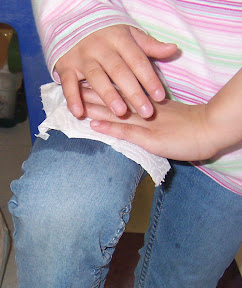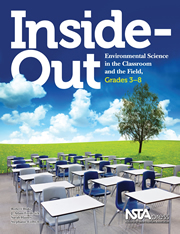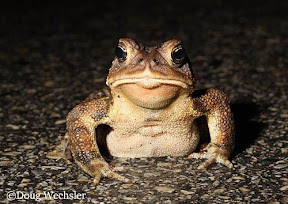Teaching science to ELLs
By Lynn Petrinjak
Posted on 2010-04-15
The United States has long been called a “melting pot,” a place where diverse people mixing and mingling. Learning the dominate language is a challenging part of the process, particularly when a student is trying to learn a new language and expand their content knowledge. Okhee Lee and Cory Buxton shared their views on teaching science to English Language Learners in the April op-ed of NSTA Reports. They write:
English Language Learner (ELL) students can now be found in virtually every school in the nation. Currently, more than 20% of U.S. residents speak a language other than English at home. According to the National Center for Educational Statistics, more than 5.5 million—11%—of public school students are currently categorized as ELL students. While Spanish speakers comprise approximately 80% of the ELL student population, U.S. students speak more than 400 different languages. Although the vast majority of U.S. ELL students attend schools in large urban districts, increasing numbers have spread into geographic regions that have not historically seen this linguistic diversity.
Read the rest of the article here.
The United States has long been called a “melting pot,” a place where diverse people mixing and mingling. Learning the dominate language is a challenging part of the process, particularly when a student is trying to learn a new language and expand their content knowledge. Okhee Lee and Cory Buxton shared their views on teaching science to English Language Learners in the April op-ed of NSTA Reports. They write:
Using Picture-Perfect Science Lessons, Expanded 2nd Edition in your classroom is easier than ever! NSTA’s ClassPacks, each sufficient for a class of 28 students, are lesson-specific collections of materials—an unmatched time-saver and a great deal. ,/p>
Picture-Perfect Science/STEM Lessons are created by classroom veterans Karen Ansberry and Emily Morgan. They know elementary educators are crunched for science instructional time and could often use refresher explanations of scientific concepts.
Using Picture-Perfect Science Lessons, Expanded 2nd Edition in your classroom is easier than ever! NSTA’s ClassPacks, each sufficient for a class of 28 students, are lesson-specific collections of materials—an unmatched time-saver and a great deal. ,/p>
Picture-Perfect Science/STEM Lessons are created by classroom veterans Karen Ansberry and Emily Morgan. They know elementary educators are crunched for science instructional time and could often use refresher explanations of scientific concepts.
This ClassPack for the book chapter "Name That Shell!" in Picture-Perfect Science Lessons, Expanded 2nd Edition: Using Children's Books to Guide Inquiry includes 14 bags with 7 types of shells per bag and 1 "Shells of North America" poster.
This ClassPack for the book chapter "Name That Shell!" in Picture-Perfect Science Lessons, Expanded 2nd Edition: Using Children's Books to Guide Inquiry includes 14 bags with 7 types of shells per bag and 1 "Shells of North America" poster.
Evaporation—children need to know the word and concept
By Peggy Ashbrook
Posted on 2010-04-11
 Is it surprising that there are no books for children titled “Evaporation”? Why this exciting subject doesn’t have it’s own title is beyond me—ha! But there are many good books that do touch on the subject in interesting ways. While we don’t need to dwell on the concept of evaporation, it should frequently be part of our vocabulary in early childhood classrooms to help children understand that water (and all matter) does not “disappear” or “go away”, but always exists, although in different forms.
Is it surprising that there are no books for children titled “Evaporation”? Why this exciting subject doesn’t have it’s own title is beyond me—ha! But there are many good books that do touch on the subject in interesting ways. While we don’t need to dwell on the concept of evaporation, it should frequently be part of our vocabulary in early childhood classrooms to help children understand that water (and all matter) does not “disappear” or “go away”, but always exists, although in different forms.
Here are a few resources about evaporation. What can you add to this list?
Online
CHEM4KIDS.com by Andrew Rader Studios
Prepare yourself to comfortably use the word “evaporation” by reading the definition and description of the process at:
http://www.chem4kids.com/files/matter_evap.html
Evaporation is a phase change—read more at:
http://www.chem4kids.com/files/matter_changes.html
Marvelous Explorations Through Science and Stories (MESS®) : Investigating Water. HHS/ACF/Office of Head Start. 2008.
Download a copy of the Teacher’s Guide, which describes many activities for hands-on exploration of the properties of water and its importance to all living things. The list of Recommended Materials includes a list of books on water.
In print
Down Comes the Rain (Let’s Read-and-Find-Out Science Book) by Franklyn M. Branley. (Scholastic Inc. 2000).
Frankly Branley’s timeless writing is engaging and accurate. The illustrations by James G. Hale include children speaking (words in balloons), promoting the concept that children do science. Read this book as an introduction to the topic of water (do the hands-on activities), or as a way to pull together children’s explorations, after the fact.
The Drop in My Drink: The Story of Water on Our Planet by Meredith Hooper. (Viking 1998). A wonderful book (with many references to evaporation) for reading aloud to just a few children because of the complexity of the path water takes around the world and the level of the vocabulary.
A Drop of Water by Walter Wick. (Scholastic 1997). The text, written for grades 3-6, will equip teachers with a good explanation of “molecules” for teaching that through evaporation, tiny pieces of water move into the air. The amazing photographs illustrate the properties of water for all ages.
River of Life by Debbie S. Miller, illustrated by Jon Van Zyle. (Clarion Books 2000). Focused on one body of water, a river in Alaska, and all the life that it supports, read this book to highlight how essential water is to life.
Where Did the Rain Puddle Go? Vol. 10 Evaporation (Winnie the Pooh’s Thinking Spot Series) by Dawn Bently. (Advance Publishers 2005).
Disney is not the company I usually think of when looking for a science title. But this book turned up on an internet search for books titled “evaporation”. I couldn’t find more information about the content, however, the description says that Pooh and friends learn “simple scientific facts while examining how young children learn through listening, questioning, observing, comparing, and experimenting” and there is a hands-on activity at the end. I shouldn’t be such a snob.
Where Do Puddles Go? by Fay Robinson (Childrens Press 1995) may inspire your class to make a puddle and then make observations over the period of recess, or a day.
Have you used the National Science Teachers Association website feature “NSTA Recommends” to look for “thoughtful, objective recommendations of science-teaching materials” on water, evaporation and any other topic? It’s available to all at no cost and also part of each journal. Here’s one sample of the results of my search for evaporation:
My World of Science: Water by Angela Royston
Price at time of review: $14.95
32 pp.
Heinemann Library
Chicago, IL
2001
ISBN: 1-58810-247-5
Grade Level: K-4
Reviewed by Monica Hayes
Middle School Teacher
“My World of Science: Water is one of ten books on physical science topics written for primary students by Angela Royston. Their conceptual level, format, and presentation make them excellent supplements to classroom activities for students at this level.
This book covers a great deal of content usually included in primary curricula: phases of water, the water cycle, and the dependence of all living things on water. The book also includes practical observations, like the water content of fruits and vegetables, and applications, such as using water to clean or fight fires. The author explores phase changes and movement of water through gravity and negative air pressure (suction). Activities demonstrate some of the more difficult concepts; for example, children can measure a puddle over time to observe evaporation. Students can also try to push a balloon under water to show that water pushes back. These experiences will help students to understand some of the unique properties of water.
Each book in this series is written at a second/third grade level to encourage independent reading, but also would be appropriate for younger students as a read-aloud. No background information is necessary for the teacher or parent. All of the books are trimmed in appealing primary colors, and photos of familiar objects at home or school place the concepts in an authentic context. These books are highly recommended for their child-friendly text and visual representations that are accurate and realistic.”
 Get the Early Years activity column, Where Did the Water Go? from the April 2010 issue of Science and Children. I’m off to water the just-sprouting pea plants because the good soaking rain from a few days ago has evaporated from the top few inches of soil,
Get the Early Years activity column, Where Did the Water Go? from the April 2010 issue of Science and Children. I’m off to water the just-sprouting pea plants because the good soaking rain from a few days ago has evaporated from the top few inches of soil,
Peggy
Air and gases
By Mary Bigelow
Posted on 2010-04-10
April is the month of Earth Day, and this issue on air and gases also has ideas for environmental studies related to the atmosphere.
The article Using Citizen Scientists to Measure the Effects of Ozone Damage on Native Wildflowers describes how students near the Great Smokey Mountain National Park in Tennessee are doing a longitudinal study of the effects of ground-level ozone on plants. The authors show how the study incorporates the 5E learning cycle, observation, data collection and analysis. There are examples of concept maps and data collection protocols to use as examples for your own projects. SciLinks has many websites with information and activities related to ozone and several have more on how ozone affects plants: The Ozone We Breathe and Ozone Spells “Ouch” for Some Plants
I live close to Hershey, PA, where Smelling the Chocolate happens whenever I travel through the town. But the authors of this article (with the subtitle The Perks of Modeling Habits of Mind) describe a student’s journey to an understanding of what causes things to “smell.” They also include a description of the activities in their unit on smell and how these activities promote critical thinking and communication.
Reading Classroom Terraria brought back a lot of memories! Having a classroom terrarium was a popular activity back in the 1970s, so it was interesting to see the newest version. This is Terrarium 2.0: using them to study plant-related processes such as evaporation, transpiration, photosynthesis, and respiration. The website Bottle Biology has more suggestions for enhancing classroom activities with bottle gardens made from recycled materials.
Speaking of recycled materials, Home Sweet Home has some great photographs of how to build homes for Madagascar hissing cockroaches from common materials. I’ll bet some students would enjoy building the homes for these fascinating insects almost as much as they do observing them. Click here if you’re not familiar with these insects or wonder if they really do hiss.
Stay on the theme of recycling and waste management with A Suggested Project-Based Environmental Unit for Middle School. The inquiry-based lesson investigated the amount and content of household garbage. (See Trash Pie: Is Your School Serving? in the March issue of Science & Children to see how a school analyzed its cafeteria waste.)
Teachable moments
By Mary Bigelow
Posted on 2010-04-07
 At a recent workshop, the presenter used the term “teachable moment.” What does this mean?
At a recent workshop, the presenter used the term “teachable moment.” What does this mean?
—Todd, Tacoma, Washington
Some say this is an overused, meaningless term. After, isn’t every moment in a science class “teachable?” But a teachable moment is a spontaneous, unplanned opportunity for learning. It’s a unique, high interest situation that lends itself to discussion of a particular topic. It could be a question from a student, an object a student brought to class, unanticipated results in a lab investigation, a misconception, or an opportunity to connect what students are learning in science to other subjects or real-world events.
You may have heard synonyms for teachable moments such as “going off on a tangent” or “taking a birdwalk.” As a teacher, you learn to recognize and take advantage of these opportunities. After the recent earthquakes in Haiti and Chile, many teachers “went on a birdwalk” about plate tectonics and seismology. It’s worth following a tangent when, for example, students remark that many science terms based on the Greek and Roman mythology they’re studying in another class—or when your class gerbil is having babies.
Sometimes, however, you might decide to delay the moment. For example, during a lab investigation, a student might raise an interesting question or have unusual results you would like to share with the others. In the interest of time, however, you don’t want to interrupt the other students. But you can make a note to come back to the idea at a later time. I know teachers who have a “parking lot” on a bulletin board where they ask students to post questions or ideas to revisit. By displaying them publically, the students know their question or contribution was valued, and they won’t let you forget about it.
One of my favorite teachable moments involved Charles (not his real name). Charles moved to our town from Jamaica. His English was hard to understand (and I’m sure our northeastern accent was difficult for him to understand, too). We found out later he was much younger than a typical seventh grader. He did not talk much in class, even though I tried to converse with him and draw him into class discussions.
Our seventh-grade culminating activity was a study at the reservoir and stream that formed the town’s backup water supply. The activity featured an analysis of the presence of aquatic invertebrates as an indicator of water quality. The students enjoyed wading in the stream, overturning rocks and using screen sieves to find invertebrates such as mayfly and stonefly larva, hellgrammites, and leeches. Charles eagerly joined in on the activity. I heard a scream, “I found a fish.” It was Charles holding up a minnow. I said, “That’s good. But let’s see if we find any invertebrates.” A few minutes later I heard another scream, “I found a crab!” Charles had picked up a crayfish. We discussed the similarities and differences between crayfish and crabs. A few minutes later, “I found a turtle!” At this point I had to make an instructional decision. Should I point out again that the lesson was about invertebrates? Or should I divert from the plan to capitalize on Charles’ enthusiasm and the first time he had really spoken out in class?
I decided on a temporary diversion. I gathered the group and asked Charles to describe what the waters were like in Jamaica and what living things he would find there. As we sat on the bank of the stream, he excitedly told the class about going to the beach with his brothers, swimming with the sea turtles, and finding crabs and sea urchins. The waters, he said, were much warmer and clearer than the stream we were studying. After a few minutes, we went back to the task of finding invertebrates, but for a little while Charles had taken us to a different type of aquatic environment. “You were really lucky to live so close to the ocean,” a student remarked to Charles, who couldn’t stop smiling for the rest of the afternoon. It was time well spent.
Feel free to share one of your teachable moments with Todd.
Photo from http://www.flickr.com/photos/fontplaydotcom/504443770/
 At a recent workshop, the presenter used the term “teachable moment.” What does this mean?
At a recent workshop, the presenter used the term “teachable moment.” What does this mean?
—Todd, Tacoma, Washington
Citizen scientist action begins at a young age—by extending a helping hand to toads
By Peggy Ashbrook
Posted on 2010-04-05
In Upper Roxborough in Philadelphia, Pennsylvania, children helped toads and frogs survive their migratory passage across a road, back to their natal pond (a reservoir) to lay their eggs. The volunteers recorded a count of toads, alive or dead. Naturalist-led toad walks help families understand the toad behavior. The Toad Detour blog has more details of the continuing effort.
Leigh Ashbrook, environmental science teacher, (and my cousin!) said, “The American toads and pickerel frogs are on the move by The Schuylkill Center, and volunteers have been helping safeguard their crossings over the busy roads by the reservoir to which they are homing to lay their eggs. The trilling of the toads is so beautiful! I lead an education “toad walk” on Saturday night, and was pleased that several families came to learn about natural history of toads and to support the detouring of local traffic during toad migration.”
For students and teachers in northern Virginia, spring break usually arrives with warmer weather. For this science teacher, it comes a little too late. I’d like to be in the schoolyard helping the children document the changes in the plants which happen so fast this time of year.
 To identify your local amphibians, check out the resources listed at the USGS site, An Online Guide for the Identification of Amphibians in North America north of Mexico. A web search for “frog calls” will turn up several sites where you can listen to calls to identify those you can hear but not see. Please note that toads and frogs can die from infectious diseases, and spread disease if they are exposed when raised in captivity and later released. The Society for the Study of Amphibians and Reptiles (SSAR) and Amphibian Ark describe how to sterilize containers before capture and after release.
To identify your local amphibians, check out the resources listed at the USGS site, An Online Guide for the Identification of Amphibians in North America north of Mexico. A web search for “frog calls” will turn up several sites where you can listen to calls to identify those you can hear but not see. Please note that toads and frogs can die from infectious diseases, and spread disease if they are exposed when raised in captivity and later released. The Society for the Study of Amphibians and Reptiles (SSAR) and Amphibian Ark describe how to sterilize containers before capture and after release.Happy spring to all,
Peggy
Science Inside-Out
By Amy America
Posted on 2010-04-02
 Spring is rapidly approaching, as indicated by the recent “springing forward” of our clocks. The arrival of Spring not only means longer days but also warmer weather, beautiful blooms, and…restless students. Luckily for teachers, you can exhaust your students’ boundless energy by taking their science lessons outside. NSTA Press’s new book, Inside-Out: Environmental Science in the Classroom and the Field, Grades 3–8, aims to engage teachers in activities that incorporate the scientific disciplines found in environmental observation. The authors’ main goal is to enhance understanding of basic environmental science concepts and to instill confidence in teachers’ abilities to engage students in the process of science learning. Each chapter heavily focuses on content knowledge and then applies this to activities that promote student inquiry. Examples of chapter topics include the study of soil, water, energy and biodiversity. In the introduction, former elementary school principal Debbie Freels recalls how “students yearned for the opportunity to be outdoors during the school day. By providing instruction through project-based teaching and learning, teachers were able to integrate cross-curricular objectives in science-oriented projects.” This time of year is a time of renewal and there is no better way to refresh your science lessons then by utilizing the beautiful outdoors and the activities found in Inside-Out: Environmental Science in the Classroom and the Field, Grades 3–8!
Spring is rapidly approaching, as indicated by the recent “springing forward” of our clocks. The arrival of Spring not only means longer days but also warmer weather, beautiful blooms, and…restless students. Luckily for teachers, you can exhaust your students’ boundless energy by taking their science lessons outside. NSTA Press’s new book, Inside-Out: Environmental Science in the Classroom and the Field, Grades 3–8, aims to engage teachers in activities that incorporate the scientific disciplines found in environmental observation. The authors’ main goal is to enhance understanding of basic environmental science concepts and to instill confidence in teachers’ abilities to engage students in the process of science learning. Each chapter heavily focuses on content knowledge and then applies this to activities that promote student inquiry. Examples of chapter topics include the study of soil, water, energy and biodiversity. In the introduction, former elementary school principal Debbie Freels recalls how “students yearned for the opportunity to be outdoors during the school day. By providing instruction through project-based teaching and learning, teachers were able to integrate cross-curricular objectives in science-oriented projects.” This time of year is a time of renewal and there is no better way to refresh your science lessons then by utilizing the beautiful outdoors and the activities found in Inside-Out: Environmental Science in the Classroom and the Field, Grades 3–8!
—Amy America



